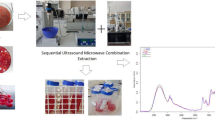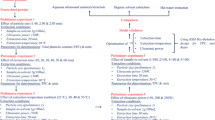Abstract
In this study, extraction of phenolic compounds from nettle by microwave and ultrasound was studied. In both microwave and ultrasound-assisted extractions, effects of extraction time (5–20 min for microwave; 5–30 min for ultrasound) and solid to solvent ratio (1:10, 1:20, and 1:30 g/mL) on total phenolic content (TPC) were investigated. Effects of different powers (50 % and 80 %) were also studied for ultrasound-assisted extraction. In microwave-assisted extraction, the optimum TPC of the extracts (24.64 ± 2.36 mg GAE/g dry material) was obtained in 10 min and at 1:30 solid to solvent ratio. For ultrasound-assisted extraction, the condition that gave the highest TPC (23.86 ± 1.92 mg GAE/g dry material) was 30 min, 1:30 solid to solvent ratio, and 80 % power. Extracts obtained at the optimum conditions of microwave and ultrasound were compared in terms of TPC, antioxidant activity (AA) and concentration of phenolic acids with conventional extraction and maceration, respectively. Microwave reduced extraction time by 67 %. AA of extracts varied between 2.95 ± 0.01 and 4.48 ± 0.03 mg DPPH/g dry material among four methods. Major phenolic compounds were determined as naringenin and chlorogenic acid in nettle.

Similar content being viewed by others
References
Abbasi H, Rezaei K, Emamdjomeh Z, Mousavi SME (2008) Effect of various extraction conditions on the phenolic contents of pomegranate seed oil. Eur J Lipid Sci Technol 110:435–440
Alekovski S, Sovova H, Curapova B, Poposka F (1998) Supercritical CO2 extraction and Soxhlet extraction of grape seeds oil. Bull Chem Technol Maced 17:129–134
Al-Ismail K, Herzallah SM, Rustom AS (2007) Antioxidant activities of some edible wild Mediterranean plants. Ital J Food Sci 19:287–296
Arbianti R, Utami TS, Kurmana A, Sinaga A (2007) Comparison of antioxidant activity and total phenolic content of Dillenia indica leaves extracts obtained using various techniques. In: 14th Regional Symposium on Chemical Engineering, Gadjah Mada University, Yogyakarta-Indonesia, 4–5 December 2007
Bayramoglu B, Sahin S, Sumnu G (2008) Solvent-free microwave extraction of essential oil from oregano. J Food Eng 88:535–540
Beejmohun V, Fliniaux O, Grand E, Lamblin F, Bensaddek L, Christen P, Kovensky J, Fliniaux MA, Mesnard F (2007) Microwave-assisted extraction of main phenolic compounds in flaxseed. Phytochem Anal 18:275–282
Bi W, Zhou J, Row KH (2011) Decaffeination of coffee bean waste by solid-liquid extraction. Korean J Chem Eng 28:221–224
Cacace JE, Mazza G (2003) Mass transfer process during extraction of phenolic compounds from milled berries. J Food Eng 59:379–389
Chemat S, Lagha A, AitAmar H, Bartels PV, Chemat F (2004) Comparison of conventional and ultrasound-assisted extraction of carvone and limonene from caraway seeds. Flavor Fragr J 19:188–195
Elmastas M, Gulcin I, Beydemir S, Kufrevioglu OI, Aboul-Enein HY (2006) A study on the in vitro antioxidant activity of juniper (Juniperus communis L.) fruit extracts. Anal Lett 39:47–65
Gallo M, Ferracane R, Graziani G, Ritieni A, Fogliano V (2010) Microwave assisted extraction of phenolic compounds from four different spices. Molecules 15:6365–6374
Ghafoor K, Choi YH, Jeon JY, Jo IH (2009) Optimization of ultrasound-assisted extraction of phenolic compounds, antioxidants, and anthocyanins from grape (Vitis vinifera) seeds. J Agric Food Chem 57:4988–4994
Gulcin I, Kufrevioglu I, Oktay M, Buyukokuroglu ME (2004) Antioxidant, antimicrobial, antiulcer and analgesic activities of nettle (Urtica diocia L.). J Ethnopharmacol 90:205–215
Herrera MC, Castro MDL (2004) Ultrasound-assisted extraction for the analysis of phenolic compounds in strawberries. Anal Bioanal Chem 379:1106–1112
Hudec J, Burdova M, Kobida L, Komora L, Macho V, Kogan G, Turianica I, Kochanova R, Lozek O, Haban M, Chlebo P (2007) Antioxidant capacity changes and phenolic profile of Echinacea purpurea, nettle (Urtica diocia L.), and dandelion (Taraxacum officinale) after application of polyamine and phenolic biosynthesis regulators. J Agric Food Chem 55:5689–5696
Japon-Lujan R, Luque-Rodriguez JM, Luque de Castro MD (2006) Dynamic ultrasound-assisted extraction of oleuropein and related biophenols from olive leaves. J Chromatogr A 1108:76–82
Ma YQ, Ye XQ, Fang ZX, Chen JC, Xu GH, Liu DH (2008) Phenolic compounds and antioxidant activity of extracts from ultrasonic treatment of Satsuma mandarin (Citrus unshiu Marc.) peels. J Agric Food Chem 56:5682–5690
Ma YQ, Chen JC, Liu DH, Ye XQ (2009) Simultaneous extraction of phenolic compounds of citrus peel extracts: effect of ultrasound. Ultrason Sonochem 16:57–62
Matsingou TC, Kapsokefalou M, Salioglou A (2001) Aqueous infusions of Mediterranean herbs exhibit antioxidant activity towards iron promoted oxidation of phospholipids, linoleic acid, and deoxyribose. Free Radic Res 34:593–605
Ozyurt D, Demirata B, Apak R (2007) Determination of total antioxidant capacity by a new spectrophotometric method based on Ce(IV) reducing capacity measurement. Talanta 71:1155–1165
Paniwnyk L, Beaufoy E, Lorimer JP, Mason TJ (2001) The extraction of rutin from flower buds of Sophora japonica. Ultrason Sonochem 8:299–301
Pinelli P, Ieri F, Vignolini P, Bacci L, Baronti S, Romani A (2008) Extraction and HPLC analysis of phenolic compounds in leaves, stalks, and textile fibers of Urtica diocia L. J Agric Food Chem 56:9127–9132
Pinelo M, Ruiz-Rodriguez A, Sineiro J, Senorans FJ, Reglero G, Nunez MJ (2007) Supercritical fluid and solid-liquid extraction of phenolic antioxidants from grape pomace: a comparative study. Eur Food Res Technol 226:199–205
Proestos C, Komaitis M (2006) Ultrasonically assisted extraction of phenolic compounds from aromatic plants: comparison with conventional extraction techniques. J Food Qual 29:567–582
Proestos C, Komaitis M (2008) Application of microwave-assisted extraction to the fast extraction of plant phenolic compounds. LWT-Food Sci Technol 41:652–659
Riehemann K, Behnke B, Schulze-Osthoff K (1999) Plant extracts from stinging nettle (Urtica diocia), an antirheumatic remedy, inhibit the proinflammatory transcription factor NF-κB. FEBS 442:89–94
Rodrigues S, Pinto GAS (2007) Ultrasound extraction of phenolic compounds from coconut (Cocos nucifera) shell powder. J Food Eng 80:869–872
Rostagno MA, Palma M, Barroso CG (2003) Ultrasound-assisted extraction of soy isoflavones. J Chromatogr A 1012:119–128
Sayyar S, Abidin ZZ, Yunus R, Muhammed A (2009) Extraction of oil from jatropha seeds-optimization and kinetics. Am J Appl Sci 6:1390–1395
Sengul M, Yildiz H, Gungor N, Cetin B, Eser Z, Ercisli S (2009) Total phenolic content, antioxidant and antimicrobial activities of some medicinal plants. Pak J Pharm Sci 22:102–106
Sezik E, Yesilada E, Honda G, Takaishi Y, Takeda Y, Tanaka T (2001) Traditional medicine in Turkey X. Folk medicine in Central Anatolia. J Ethnopharmacol 75:95–115
Shalmashi A (2009) Ultrasound-assisted extraction of oil from tea seeds. J Food Lipids 16:465–474
Singleton VL, Rossi JA Jr (1965) Colorimetry of total phenolics with phosphomolybdic-phosphotungstic acid reagents. Am J Enol Vitic 16:144–158
Singleton VL, Orthofer R, Lamuela-Raventos RM (1999) Analysis of total phenols and other oxidation substrates and antioxidants by means of Folin-Ciocalteu reagent. Methods Enzymol 299:152–178
Sonsuzer S, Sahin S, Yilmaz L (2004) Optimization of supercritical CO2 extraction of Thymbra spicata oil. J Supercrit Fluids 30:189–199
Tsubaki S, Sakamoto M, Azuma J (2010) Microwave-assisted extraction of phenolic compounds from tea residues under autohydrolytic conditions. Food Chem 123:1255–1258
Tung YT, Chang WC, Chen PS, Chang TC, Chang ST (2011) Ultrasound-assisted extraction of phenolic antioxidants from Acacia confusa flowers and buds. J Sep Sci 34:844–851
Yarnell E (1998) Stinging nettle. Altern Complement Ther 4:180–186
Yildiz L, Sozgen Baskan K, Tutem E, Apak R (2008) Combined HPLC-CUPRAC (cupric ion reducing antioxidant capacity) assay of parsley, celery leaves, and nettle. Talanta 77:304–313
Author information
Authors and Affiliations
Corresponding author
Rights and permissions
About this article
Cite this article
Ince, A.E., Sahin, S. & Sumnu, G. Comparison of microwave and ultrasound-assisted extraction techniques for leaching of phenolic compounds from nettle. J Food Sci Technol 51, 2776–2782 (2014). https://doi.org/10.1007/s13197-012-0828-3
Revised:
Accepted:
Published:
Issue Date:
DOI: https://doi.org/10.1007/s13197-012-0828-3




